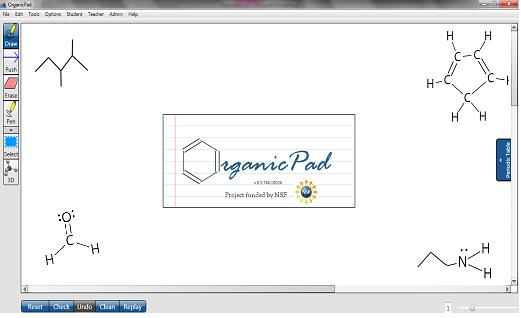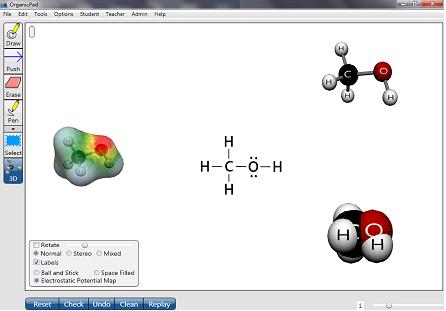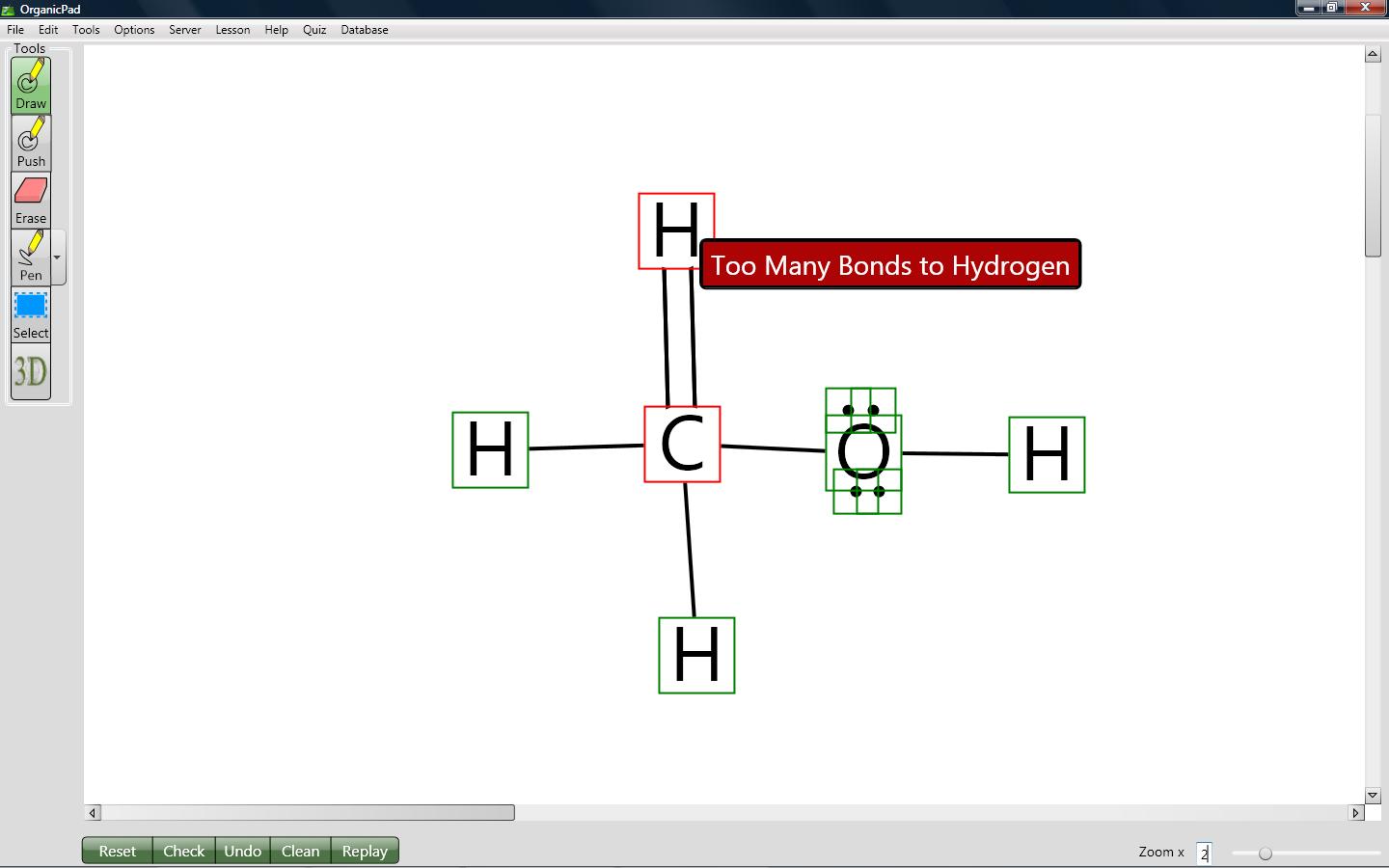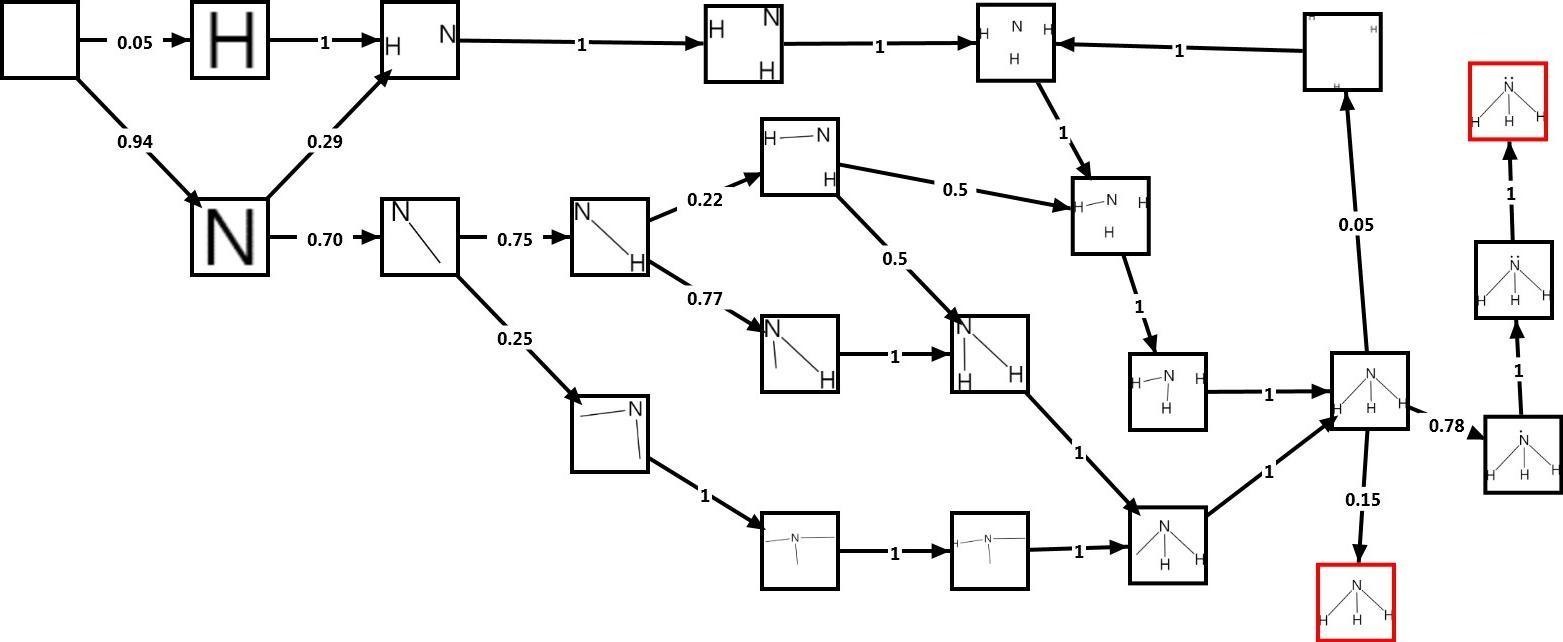
Figure 1. OrganicPad with examples of some of the representations that can be drawn.
One reason chemistry poses a challenge to both learners and teachers is that, for robust conceptual understanding, students must understand how and why molecular level structure affects reactivity and properties. Much has been written on the difficulties students have in translating between a symbolic, molecular, and macroscopic understanding of chemistry (1, 2) and most modern texts go to great lengths to provide multiple representations to students.1 Lewis structures are probably the most important of the symbolic representations that students encounter. Students must master not only what the representations mean, but also how and why they are constructed, and what they are used (and useful) for. Unfortunately, many students have great difficulty both drawing and using Lewis structures. For example in our work we have seen that the majority of students (even in an organic chemistry course) do not appear to use structures to predict properties in a meaningful way (3). Many students (and perhaps some instructors) confuse the rules for drawing structures with the concepts that underlie bonding, resulting in students who believe that bonds form because atoms "want" or "need" an octet (4, 5). Indeed the idea that Lewis structures are symbolic representations may well be lost on many students (for example: if asked what the bond angle is in methane, when presented with a typical Lewis structure, many students will answer 90 ).
These problems notwithstanding, learning to draw and use Lewis structures accurately and effectively remains an integral part of most general chemistry courses, and is an especially important skill for those students planning to move on to organic chemistry. The development of these skills during general chemistry is all the more important since many organic chemistry instructors assume (erroneously as our work has shown) that students have mastered this skill before they begin the course (3).
There is a fairly large literature on "improved" ways for students to learn to draw structures, but unfortunately this is one of those tasks that requires "bootstrapping" as Taber calls it (6). For many structures, it is difficult to elucidate the connectivity between the atoms correctly unless you already know what the structure should look like. In other words, the students are caught in a kind of "Catch 22". The solution to these problems is practice and a growing familiarity with the typical types of structures that are normally encountered in introductory chemistry courses. This familiarity is often difficult to obtain if beginning students are required to draw the many exceptions to the "rules". Another common approach is to require students to draw only structures where there is one central atom (noble gas compounds, inter-halogen ions and the like - many of which they will never meet again), which results in our distressing finding that many organic chemistry students have significant trouble drawing organic molecules with more than one carbon atom (3). Ideally, in order to master the basic skills, students need practice and immediate feedback that prompts them to think critically about what they are doing, rather than simply providing the correct answer.
Since Lewis structures are in fact rule-based representations, technological solutions are clearly appropriate, and there have been a number of systems developed that will recognize and grade input from students. While many of these systems are widely adopted and have been incorporated into publishers' course management systems, there remains the problem that the interface is typically not naturalistic, and students (who are already struggling with learning to draw structures) must also face fairly steep learning curves as they drag and drop atoms and bonds, choose items from a template, and place them in fairly limited positions on the screen.
It was in this light that we developed OrganicPad, (Figure 1), a freehand interactive tablet-PC based program that can recognize and respond to student input in a variety of ways and a variety of settings.

Figure 1. OrganicPad with examples of some of the representations that can be drawn.
OrganicPad has a number of features. Using the draw mode, the program can recognize atomic symbols, bonds, lone pairs and charges. Once a structure is drawn, it is possible to convert it to a 3D representation, as shown in Figure 2. The 3D mode allows student to convert a structure to ball and stick, space filling models and/or electrostatic potential maps. In the pen mode the screen is just like a blank sheet of paper allowing teachers and students alike to annotate the structures that they are creating. The push tool allows students to draw curved arrows when they are representing electron flow during organic chemistry mechanisms. It is important to note that in draw, pen, and push modes the students' input is recorded in a database for further analysis.

Figure 2. Types of 3D representations that can be produced with OrganicPad.

Figure 3. An example of feedback.
While this mode, in itself, can be very useful, we have developed a more sophisticated feedback system, for a limited set of structures, in which contextual responses have been developed to provide the student with increasingly directed feedback as they move through the task of structure drawing. An example of this is shown at (http://www.youtube.com/watch?v=CAqCashseYI). The feedback is based on our studies of how students often proceed as they write Lewis structures, and common errors that they make (3). We are currently conducting studies on how working with this kind of contextual feedback impacts student abilities.

Figure 4. A Markov Model for Ammonia.
In addition to providing us with an indepth knowledge of the likely pathways students may utilize in creating their structures, the Markov models obtained through the use of OrganicPad also provide us with actionable information which we have used to create the contextual feedback system described above.
We have also used OrganicPad extensively to investigate how students draw mechanisms for organic reactions. Most organic chemists teach mechanistically, and assume (hope) that students will, in passing, learn to use the tools necessary for them make sense of the huge amount of material. We are currently analyzing data and preparing manuscripts on that analysis - but preliminary indications are that most students in organic chemistry do not spontaneously use mechanisms to guide their approach to predicting products of reactions. Those that do appear to be better equipped to solve far transfer tasks provided to them.
Acknowledgements: This work is funded by NSF grant DRL-REESE #0735655 and NSF-CCLI #0816692.